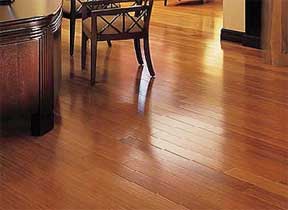|
| |
Bamboo flooring
:Construction tips & Concepts
Main
Article page |
Beauty articles
|
Health page |
Computers|
Diseases |
Education |
Entertainment |
Family
Business |Fitness|
Fruits and Vegetables
|
Jobs |
General |
Personality|
Technology
|
Tourism |
Sports
House Plans |
House Loans |
Real Estate|
Vaasthu
Shastra|
Construction Tips
Engineering page
| Interior Design |
Property Buying Tips |
Renting Tips |
Journals /
Magazines
Education | List of Colleges |
Entrance

Bamboo floors are manufactured from the
bamboo plant. The majority of today's bamboo flooring products originate in
China and other portions of Asia.
Bamboo is an attractive alternative for
flooring because of its physical similarities to hardwoods. Bamboo floor
manufacturers and sellers promote its strength, durability as well as
resistance to insects and moisture while having the added benefit of being
eco friendly.
Different forms of bamboo flooring exist. Each varies in its manufacturing
process and differs largely based on economic viability and local
preferences.
Most Common Type of Bamboo Floor
The most common form, particularly in southeast Asia, uses thin bamboo
stems that are cut as flat as possible. They are cut to similar lengths and
can be stained, varnished, or simply used as is. They are then nailed down
to wooden beams or bigger pieces of bamboo stems. This form results in more
space between each bamboo stem; flatness and tightness is not emphasized.
This technique is usually used on stilted houses, resulting in better air
circulation especially during the warmer summer months
.
Manufactured Bamboo Floor
The manufactured bamboo flooring commonly found in North American
markets is highly processed. Bamboo flooring is typically made by slicing
mature bamboo poles or culms into strips. These culms are crosscut to length
and then sliced into strips depending on the width desired. The outer skin
and nodes are removed. To remove starch and sugars the strips of bamboo are
boiled in a solution of boric acid or lime. The bamboo is then dried and
planed. Natural bamboo color is similar to beech wood. If a darker color
similar to oak is desired, the bamboo goes through a carbonizing process of
steaming under controlled pressure and heat. The carbonizing process can
reduce the floor’s final hardness significantly compared to non-carbonized
bamboo, rendering it softer than some pines and softer than more common red
oak.
Most bamboo flooring uses a urea-formaldehyde (UF) adhesive in the
lamination process. Though the use of UF resins, which emit volatile organic
compounds (VOCs), is harmful to indoor air quality, bamboo flooring uses a
relatively small amount compared with other materials, such as
particleboards. Bamboo flooring products that avoid formaldehyde use are
available, including some listed in the GreenSpec Directory. The panels are
then heat pressed to cure the adhesive. The cured boards are then planed,
sanded, and milled. Finally an ultraviolet curing lacquer is applied to the
boards.
Manufactured bamboo floors are typically made available in planks with
either vertical- or horizontal-grain orientation. In vertical bamboo floors,
the component pieces are stood vertically on their narrowest edge and then
press laminated side to side. The effect is a lined, almost uniform look to
the surface of the finished floor plank. In horizontal bamboo floors, the
slats are arranged in a horizontal direction, on their widest edge, and then
joined side by side with adjacent pieces using a high-pressure laminate
system. The characteristic nodes of the bamboo are visible on the finished
horizontal surface.
Locking bamboo flooring is the easiest to install. Individual flooring
planks have interlocking joints that click precisely into place. By
combining plank alignment and color a lot of different styles can be
produced.
ADVANTAGES OF BAMBOO FLOORING:
27% harder than Northern Red Oak
13% harder than hard Maple
Finished with a durable aluminum-oxide coating
Nail down, glue down, or floating
A better performer than most select hardwoods in terms of hardness, dimensional
stability, and flammability
Can be installed like any other hardwood floor
Articles:
-
House plans, home plans, plans, residential plans
-
House Loans, home loans, where to get housing loan
-
How do loans work, the basic concepts of loans
-
Construction Tips, construction guide lines,
-
house rental tips, rental tips, renting properties
-
Real Estate
-
Flooring
-
What is Reverse Mortgage
-
Guidelines to purchase residential properties
-
Lotus-shaped 91 feet prayer hall in kerala
-
What is Interior Design, interior desings, resources
-
Interior Design Colleges
-
Interior Design- Bed Rooms
-
Interior Design- Bath Rooms
-
Kitchen Designs, kitchens
-
Modern Architectural Design Softwares
-
Landscaping Designs landscape architectures
-
-
|
|
| |
|



